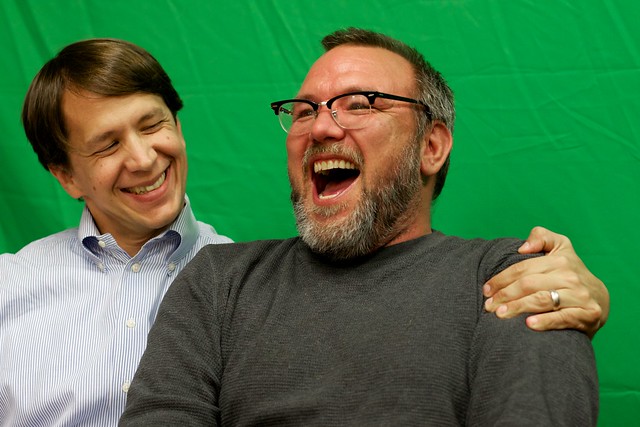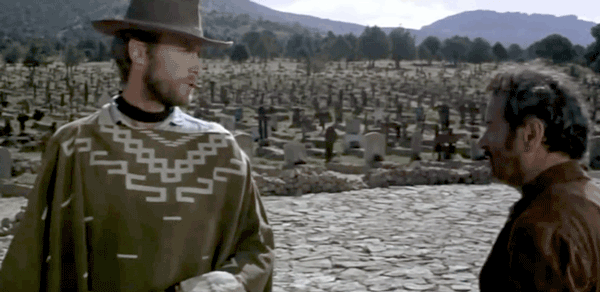
As I am writing this I am also listening to an episode of the DS106 Good Spell, a radio show only available on DS106 Radio hosted by John Johnston and Mariana Funes.
The series has been running for 3 years, where they discuss 106 “bullet points” about DS106 based on a post Mariana published December 14, 2013. This followed their experience in the “headless ds106” that was a version of the open digital storytelling course, where… there was no teacher, only open participants.
(insert tape rewind sound effect)
Three years after finishing an open course, two of its participants are still actively participating in DS106.
In the time DS106 has been going on, MOOCs were “invented” at Stanford University, it’s innovators spun out companies that boasted of disrupting education (all three have pivoted away from their zeal back into private industry). The real inventors of the MOOC? The Canadians? They’ve moved on to other projects. The original Connectivism MOOC from 2008 is not even on the web, deleted by its university host. The Rhizome people still rally, but Dave Cormier has moved to other projects.
As far as I know, no one was done a dissertation, or for that matter, any research on DS106. The Gates Foundation has not granted any money to study it, nor have any conferences been organized around it. It’s not been cover stories in any technology or ed-tech news. There are maybe academic papers that reference it, but I am not sure of it being the topic of any outside the one I co-authored with Mariana Funes and Rochelle Lockridge.
And do you know what? The lack of attention is also lacking in importance. Mostly, I guess, it’s because people just do not know, looking in from outside, what to make of DS106.
Right now, in addition to John and Mariana’s radio show, ongoing activity of the Daily Create, for Fall of 2016, more than five years after the first open DS106, there are four different versions being taught as classes at 3 universities:
- UMW Fall 2016 (Paul Bond)
- UMW Fall 2016 “The Cover Page” (Kris Shaffer)
- K-State Digital Media II (Bill Genereux)
- CU Denver’s INTE 4340/5340 (Lori Elliott)
I’ve tried to keep an active history of various DS106 courses that have been offered. If my summary is correct, in it’s time, there have been 44 university associated course sections taught via DS106, by 19 different instructors (a few of these had co-instructors):
- UMW (22 sections) Paul Bond 5, Kriss Shaffer 1, Jenn Polack 3, Jim Groom 8, Martha Burtis 4, Alan Levine 4
- Kansas State (4 sections) Bill Genereux
- CU Denver (4 sections) Lori Elliott 2, Remi Holden 2
- York College / CUNY (4 sections) Michael Branson-Smith 4, Chloe Smolarski 1
- Kennesaw State University (3 sections) Ryan Rish 2, Darren Crovitz
- Temple University, Japan (2 sections) Scott Lockman
- St Johns University (1 section) Jennifer Travis 1
- George Mason University (1 section) Alan Levine
- University of Michigan (1 section) Brian Short
- SUNY Cortland (1 section) Cynthia Sarver
- Jacksonville State University (1 section) Tanya T. Sasser
And we heard from Dean Groom that he is bringing 105 106 middle school students into DS106 soon.
Pretty excited about putting all 105 middle schoolers into #ds106 next term. We're geeked up and ready for the Open Course. FTW.
— Dean Groom (@Type217) September 14, 2016
Past students still chime in
Loved that #ds106 was all about that approach & provided net of resources for when things got TOO broken. :) & does still, even for alums!
— Haley (@haley_exe) September 10, 2016
That must not be of any relevance. Nor is the fact that the ds106 site has aggregated over 66,000 participants blog posts. There is no data to study there. The web site currently syndicates more than 1600 blogs That is not significant.
If I am overly exuberant about DS106 it is because it is hands down, the most important, valuable, sustaining thing I have been part of in 23 years of ed-tech work. As that space becomes more commodified, fraught with disparity, like some old grey mare, DS106 continues to fuel my spirits.
The work on Feed WordPress and Syndication? That led to at least 10 more gigs designing sites that use the approach of blog syndication. Turning the Daily Create and the Assignment Bank into generic themes, now used by several other courses/projects, have amped up my WordPress chops into the area of building SPLOTS. I put all of those bits and bobs together in assembling the UDG Agora web sites.

But mostly what has been the cats meow with DS106 are the people it has connected me with, as colleagues, friends. I have visited DS106ers across North America, New Zealand, Australia, the UK, Scotland.
In light of the recent ed tech “debate” on the role of institution, culture, individual, it’s worth noting:
- No institution “owns” DS106. An outcome of the 2012 DS106 Kickstarter done set up this situation where the web site is hosted not where it was “born” but donated by Reclaim Hosting.
- No individual “owns” ds106. Yes, many might think Jim Groom is the figure head, and while he instigated, so many people have played part in making the online pieces- Martha Burtis, Tom Woodward, Tim Owens, Me, Grant Potter. People like me and Mariana Funes have kept, and keep the Daily Create publishing every day since January 2012. People come and go.
- There is no single DS106. See the list of different courses above. It has been taught as a computer science, art, english, courses and more. It is more than a course.
Is that what has helped sustain it?
I recognize my enthusiasm from DS106 is from being long exposed to it’s creative radiation. Others have different experiences, may even see it as silly, a cult, not relevant. That’s okay. You just have yet to have a good exposure. Take a hint from the Man With No Course.

And so, I cast a speculative question upon the twitters…
Can you even name a Coursera course you did 3 years ago much less one you still engage with? #MOOCs4weeks #ds1064life
— Alan Levine (@cogdog) September 11, 2016
And people did respond. With a handful.
@cogdog Internet History Technology Security from @drchuck
— Phil Hill (@PhilOnEdTech) September 11, 2016
@cogdog EDCMOOC via Edinburgh and MOMA's first MOOC. But to be fair, I wrote a dissertation on topic. I've also failed to complete dozens
— Rolin Moe (@RMoeJo) September 11, 2016
@cogdog I can do better.
1. Modern & Contemporary American Poetry
2. Origins – Formation of the Universe, Solar System, Earth and Life— Gaveen Prabhasara (@gaveen) September 17, 2016
@ModPoPenn @cogdog Hey Alan, you really need to sign up for #ModPo. I've been taking the Course for 5 years now. Truly amazing. Unique!
— Malena Acco (@Malena_Acco) September 17, 2016
And so I am looking at Modern and Contemporary Poetry (#ModPo) now in it’s 5th or more year hosted in yucky Coursera:
ModPo is a fast-paced introduction to modern and contemporary U.S. poetry, with an emphasis on experimental verse, from Emily Dickinson and Walt Whitman to the present. Participants (who need no prior experience with poetry) will learn how to read poems that are supposedly “difficult.” We encounter and discuss the poems one at a time. It’s much easier than it seems! Join us and try it!
During the 10 weeks of the course, you will be guided through poems, video discussions of each poem, and community discussions of each poem. And (unique among open online courses) we offer weekly, interactive live webcasts. Our famed TAs also offer office hours throughout the week. We help arrange meet-ups and in-site study groups.
If you use Facebook, join the always-thriving ModPo group: from inside Facebook, search for “Modern & Contemporary American Poetry” and then request to be added as a member. If you have any questions about ModPo, you can post a question to the FB group and you’ll receive an almost instant reply.
We tweet all year long at @ModPoPenn and you can also find ModPo colleagues using the hashtag #ModPoLive.
ModPo is hosted by—and is housed at—the Kelly Writers House at 3805 Locust Walk on the campus of the University of Pennsylvania in Philadelphia USA. All ModPo’ers are welcome to visit the Writers House when they are in our area. Our discussions are filmed there. Our live webcasts take place in the famed “Arts Cafe” of the House. To find out what’s going on at the Writers House any time, just dial 215-746-POEM.
Watch the intro video
Or see how vibrant the #modpo hashtag is in twitter. This course kind of bunks my “nothing like DS106” since, despite it’s platform, has a lot of open elements of goodness to it. It has that DS106 mix of registered student participants overlapping with open. It has its zealots (and thanks to them for responding to my tweet)
So I may be giving it a go with the current course.
And so I am left with not being able to define any “formula” for a successful open course. We know it’s not counting the finishers. But, as ModPo teaches me, it is also not the platform that matters. Hitching your open course to a WordPress Syndication hub OR Coursera matter much less than the community, energy, and human individuality (the weird X-factor).
I might be writing a poem about it ;-) #ModPo4life? In my ratty old ds106 t-shirt.
My limited edition DS106 t-shirt, still part of my active fashionless collection. Designed by Giulia Forsythe, this was among the prime rewards for supporting the DS106 Kickstarter done in 2012 (the socks are coming! the socks!).
I wore this short in Vancouver last week, and the lady working in thw Mom’s Grilled Cheese foodtruck said “I love that album”. Yeah.
This is my photo of my 4 year olf t-shirt https://flickr.com/photos/cogdog/29657601012 shared under a Creative Commons (BY) license
The post ““Are you still wearing that 4 year old #DS106 t-shirt?” (what part of #4life do you not understand?)” was originally pulled charred and crispy from a smoky charred oven at CogDogBlog (http://cogdogblog.com/2016/09/ds106-tshirt/) on September 18, 2016.


Add a comment